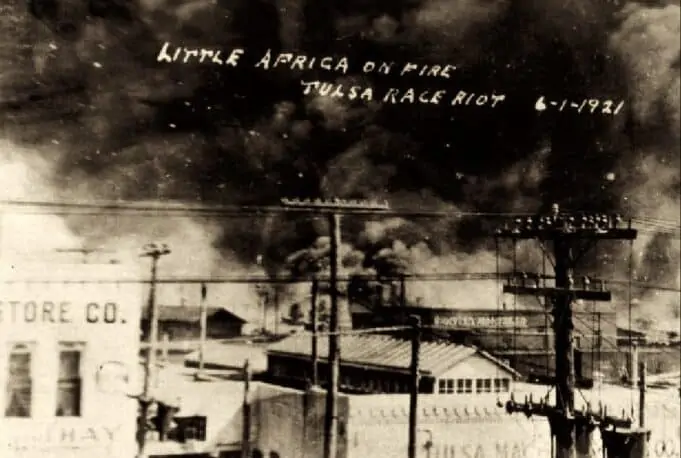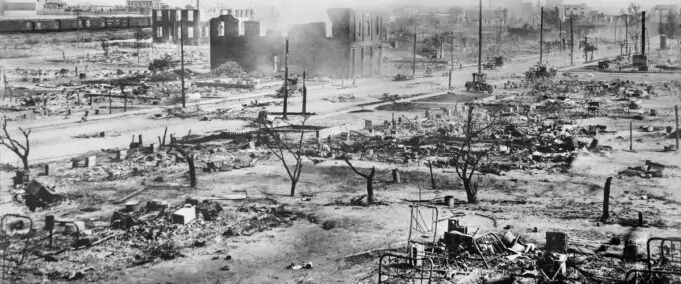1h 38min | Drama | 2021 (USA)
Recently a survivor of the 1921 Tulsa Greenwood Massacre testified before a Congressional subcommittee. At age 107, Viola Fletcher remembers vividly the 18 hours of terror in her previously peaceful neighborhood. Upwards of 300 residents were killed, and thousands were made homeless as the prosperous Greenwood section of Tulsa was burned to the ground by outsiders armed with machine guns, while private airplanes dropped incendiary bombs.
Congresswoman Barbara Lee issued a statement commemorating the 100th anniversary of the Tulsa Greenwood Massacre, and President Joseph Biden will speak of this solemn occasion in Tulsa, Oklahoma, a few days from now.
Besides interviews over the years with a dozen survivors of the 1921 attack, we have a ten-page first-person account from attorney Buck Colbert Franklin (1879-1960), which was turned over to the Museum of African American History in Washington DC. Attorney Buck Franklin was the father of famed historian John Hope Franklin (1915-2009).

Most have not heard of this violent period in American history because the governments of Tulsa and Oklahoma wiped the incident from official records decades ago. A few television watchers became aware due to fictional accounts in two series, Watchmen and Lovecraft Country, in 2019-2020. Now there are three documentaries available this week for an in-depth education:
- Tulsa Burning – History Channel, May 30th
- Tulsa: the Fire and the Forgotten – PBS, May 31st
- Dreamland: The Burning of Black Wall Street – CNN and HBO, May 31st
The Dreamland documentary has a number of executive producers, including basketball legend Lebron James. Featured in the film are sobering testimonies of Viola Fletcher and two of her siblings, who lived in the Greenwood section of Tulsa in 1921. In less than 24 hours a prosperous neighborhood of self-made Americans of color was burned to the ground, destroying 190 businesses and hundreds of homes. Those who testified recently, and survivors who were interviewed on other occasions, seek recognition and remembrance.
Chief among the defenders of Greenwood, also known as the Black Wall Street, were veterans of World War I [1914-1918], who had fought in France and who returned to the U.S. hoping for improved prospects. Some veterans were lynched in their uniforms when they returned to their home states.
The Dreamland documentary draws the viewer in with fascinating photographs of a lost way of life — happy families with successful small businesses in a segregated section of Tulsa. There were churches, schools, a library, hospital, professional offices, two newspapers. These residents, of Black and Indigenous heritage, were tasked with pulling themselves up by their bootstraps and they did so. Their success aroused jealousy in others.
There remains trauma from the massacre, the destruction of a way of life, and the missing ancestors.
The Dreamland documentary points out that Oklahoma was a territory when the Five Civilized Tribes — Chickasaw, Creek, Cherokee, Choctaw and Seminole — were coerced into walking from southeastern states to Oklahoma territory on the infamous Trail of Tears. Many hundreds died in the process. Intermarried with Blacks, many of whom had been enslaved by the Tribes, many refugees prospered when oil was discovered on their new lands. Greenwood in Tulsa was one of the most successful Black communities in the U.S.
Interviews with the elders who remember, with their descendants, and with local political figures fill in the blanks for viewers. Oral history and rumors of unmarked graves finally spark open questioning over the decades. A commission is established. Slow but steady progress is made. Restless ghosts are referenced by some of the searchers for justice. Descendants of those who seek justice speak of red birds circling the Oaklawn Cemetery when the first bones are discovered in unmarked graves, through the use of ground-penetrating radar.
There remains trauma from the massacre, the destruction of a way of life, and the missing ancestors. The search for what happened to Greenwood is essential to help heal the wounds. Participants in the research speak of recognizing resilience and rebuilding community.
Dreamland is a beautifully produced and moving documentary.



